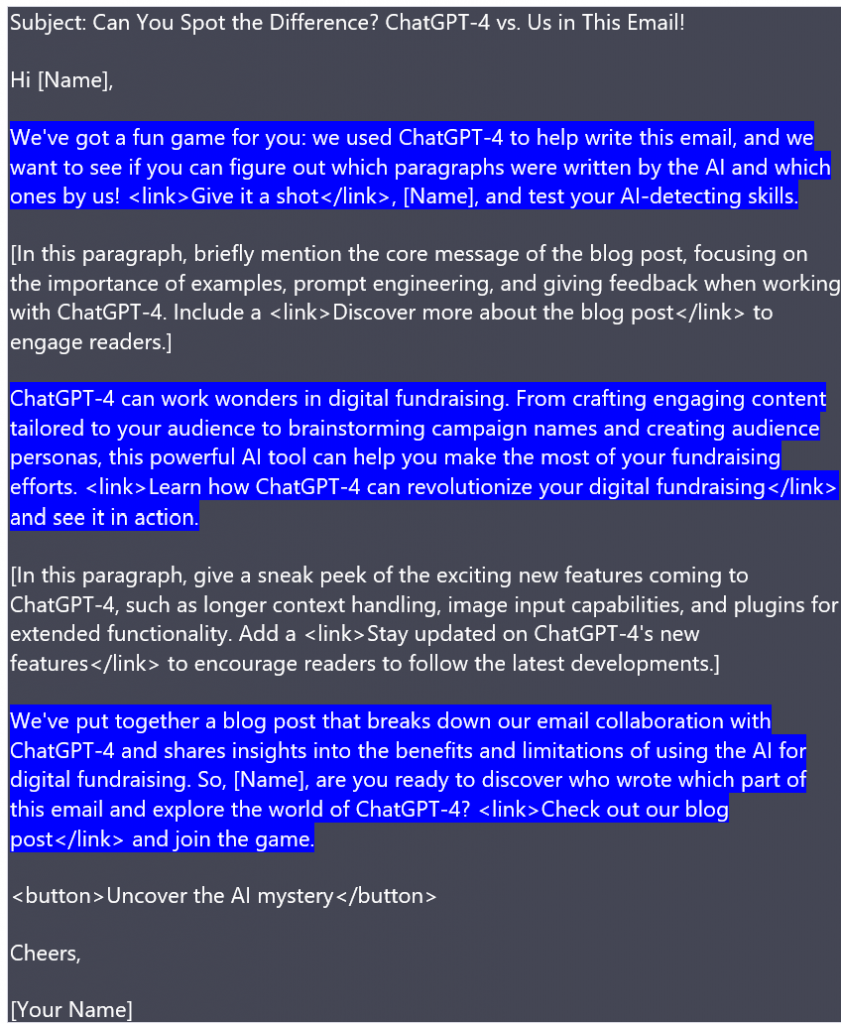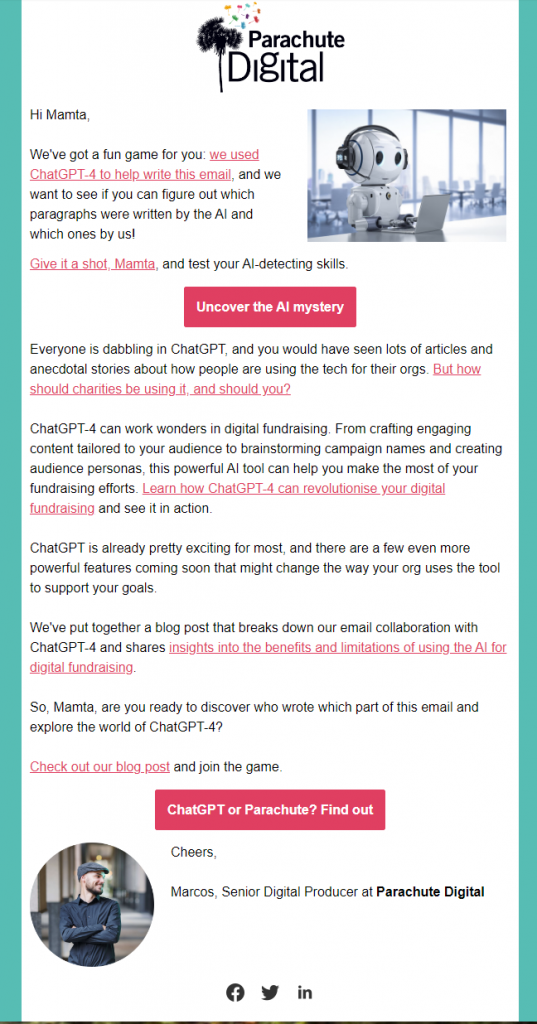OpenAI has recently released a new version of ChatGPT using GPT-4, available to the paid users of ChatGPT. We take a deep-dive about how your charity could use it, and whether you should.
But first, the big reveal…
When we wanted to share this post with you, we thought it would be interesting to let ChatGPT-4 write parts of the email, and we wrote other parts. How did that work?
Well, we just explained ChatGPT-4 what we wanted to do in a prompt

After going back and forth and finetuning what we wanted (using the advice we talk about later in this post), we ended up with the email we sent to our subscribers. Here was the final output from ChatGPT-4:

Which in turn was applied to the actual eDM we sent:

(If you come from that eDM, leave a comment letting us know how you did! Did you figure out which parts were written by ChatGPT and which parts were written by us?)
So, how can you use ChatGPT-4 in your fundraising?
Examples are the key. ChatGPT-4 is a statistical model, so it will try to “guess” what are the next words that are more likely to continue the text that you have started in your prompt. This means, that if you give it examples, it will “understand” better what you’re after. In our example, we included a previous eDM we sent to our database, to let it get the tone, wording and length of our emails.

You can even make up your own structure or way to format the output, which will help ChatGPT-4 know what you’re after and will imitate it. This is a whole new study field called “prompt engineering”, (there are already online courses about it!) but there are no official way to do it. I found out that wrapping examples between “[START OF EXAMPLE]” and “[END OF EXAMPLE]” tends to work better. Is there something in ChatGPT-4 code or documentation that indicated this is the way to do it? No, but ChatGPT-4 gets it anyway. Part of the feedback we gave during the build of the eDM was regarding the formatting, we “agreed” the output format to be used as part of the prompt, as in ‘You can wrap the text that should be linked between <link></link>, for instance “<link>Don’t miss out on discovering who wrote each paragraph</link>”’ and the output followed that formatting.


As you can see from the previous example, another key point is the feedback. Don’t forget about the “Chat” part of “ChatGPT”! It’s not built to give you exactly what you want in the first iteration, but it’s a conversation instead, so you can (and probably will need to) give it feedback to make the necessary adjustments until you get your desired result.
Some Examples
The list is long, but here are some broad examples about how you can apply the above steps and use ChatGPT-4 in Digital Fundraising:
- Write content: You can give ChatGPT-4 a few bullet points with what you want to talk about, and it will generate the full copy. Again, giving examples makes a huge difference, since it will copy the type of language and tone.
- Summarise: You can input a piece of content and ask for its 10 key ideas. You could even go a step further and use that to make a “Copy to eDM” tool. Simply include the brief or website content as [CONTEX], plus some examples of previous eDMs and request creating a new eDM based on those.
- Tone adjustment: Does your ad copy seem too direct? Or too vague? ChatGPT-4 can also help with this. You can set examples and score them, the more examples (and scores) it gets, the better it will understand what influences the scoring. Then you can use that score in your desired output. Here’s a quick example just to illustrate the concept in which we made up a “HARSH-LEVEL” score:

- Brainstorming ideas: Any kind of ideas – from campaign names to different ways of writing a sentence, or alternative subject lines. The more details the better. For example, “Please give me name ideas for a running event to raise money for a mental health charity” might seem good enough on first sight, but it will give you rather generic ideas. You can literally copy paste the “About us” page of your website and the campaign brief, and THEN ask for the name ideas.
- Persona Creation: Using you website (or campaign) information as a the input, you can ask Chat-GPT 4 to create an audience persona out of that, which can be very detailed. In this example, we input the content of this page from Paralympics Australia: https://fundraise.paralympic.org.au/donation (which includes a FAQ) and requested the Persona. This was the output:


- Understanding performance: This is more experimental and we’re still testing it, it requires a bit of work beforehand, it’s limited by the current prompt length limit (around 3,000 words) and it doesn’t take into consideration the images – but it still gave us interesting insights. We exported the ad copy and the corresponding CTR of a bunch of ads, then in Excel we created a rule to determine whether they worked or not (like, “If CTR is higher than X, then YES, otherwise NO”), still in excel we’ve used concatenate to output this format for each ad “[AD TEXT]: ‘<<Here goes the ad text>>’ [DID IT WORK?]: ‘<<Yes or No>>’”. Finally we plug that into a prompt and asked ChatGPT-4 to explain the performance. This was the result:

What Next?
There are a few very exciting features coming soon to ChatGPT.
- Changes in GPT-4: Even though we can access GPT-4 using ChatGPT, the main practical improvements are not applied to ChatGPT yet, however we can expect them to come in the near future. You can read more on OpenAI’s official website, but these are the main 2:
- Longer Context: GPT-4 will be able to handle around 25K words of text (a big improvement from the current 3K).
- ChatGPT-4 will be able to take images as inputs and generate captions, classifications, and analyses.In the GPT-4 Developer Livestream, they even created a (very simple but functioning) website using just the hand-drawn mock-up as the input:

- Maybe even more importantly, OpenAI has announce that there will be plugins that you will be able to add to ChatGPT to extend its functionality (like connecting it to the internet, generating charts, uploading files, among others). It’s not clear how these will work beyond the demos, as it’s a really new announcement (it was announced 4 days ago at the time of writing this), but in their own words: plugins can be “eyes and ears” for language models, giving them access to information that is too recent, too personal, or too specific to be included in the training data.
Limitations & Risks
The main limitation of ChatGPT-4 is rooted in its very nature: as we mentioned before, it’s a statistical model, meaning you can’t be 100% sure of what it will output. Also, sometimes it hallucinates, meaning that it outputs nonfactual information, as if it was factual. This is expected, because it’s a “text generating” tool, but you must not forget about that. Take it as companion and assistant, not as a source of truth.
ChatGPT is relatively safe to use at the moment since it’s a self-contained product, it is exposed to bugs and exploits, but so does any other website in the internet.
There are concerns, however, when these models can access the internet (like with the soon-to-come plugins or with Bing’s GPT powered assistant) since they could be subject of malicious use by ill intended people. It’s a new and exciting technology but that also implies that we don’t even know how it can be used against us, for example through “prompt injection”, a new technique in which a hacker intercepts the user’s prompt and change it to their benefit. There have also been ethical issues raised and questions about the carbon footprint of ChatGPT.
It’s not to make you panic or get paranoid, but something to consider before using this new tech for your org.
